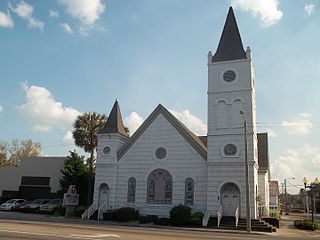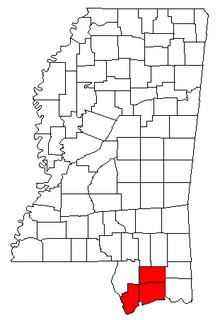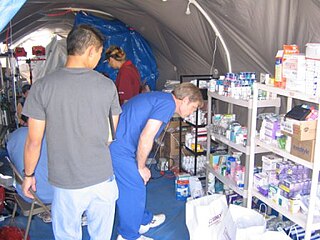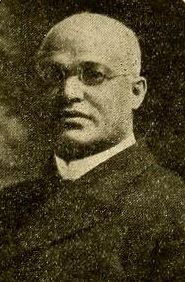Related Research Articles

Hancock County is the southernmost county of the U.S. state of Mississippi and is named for Founding Father John Hancock. As of the 2010 census, the population was 43,929. Its county seat is Bay St. Louis.

Waveland is a city located in Hancock County, Mississippi, United States, on the Gulf of Mexico. It is part of the Gulfport–Biloxi, Mississippi Metropolitan Statistical Area. The city of Waveland was incorporated in 1972. As of the 2010 census, the city had a population of 6,435. Waveland was nearly destroyed by Hurricane Camille on August 17, 1969, and by Hurricane Katrina on August 29, 2005.

Wilberforce University is a private historically black university in Wilberforce, Ohio. Affiliated with the African Methodist Episcopal Church (AME), it was the first college to be owned and operated by African Americans. It participates in the United Negro College Fund.

The Methodist Episcopal Church (MEC) was the oldest and largest Methodist denomination in the United States from its founding in 1784 until 1939. It was also the first religious denomination in the US to organize itself on a national basis. In 1939, the MEC reunited with two breakaway Methodist denominations to form the Methodist Church. In 1968, the Methodist Church merged with the Evangelical United Brethren Church to form the United Methodist Church.

Richard Allen was a minister, educator, writer, and one of America's most active and influential Black leaders. In 1794, he founded the African Methodist Episcopal Church (AME), the first independent Black denomination in the United States. He opened his first AME church in 1794 in Philadelphia.

The African Methodist Episcopal Church, usually called the AME Church or AME, is a predominantly African American Methodist denomination. It adheres to Wesleyan-Arminian theology and has a connexional polity. The African Methodist Episcopal Church is the first independent Protestant denomination to be founded by Black people; though it welcomes and has members of all ethnicities.

The Christian Methodist Episcopal (C.M.E.) Church is a historically black denomination within the broader context of Wesleyan Methodism founded and organized by John Wesley in England in 1744 and established in America as the Methodist Episcopal Church in 1784. It is considered to be a mainline denomination. The CME Church was organized on December 16, 1870 in Jackson, Tennessee by 41 former slave members with the full support of their white sponsors in their former Methodist Episcopal Church, South who met to form an organization that would allow them to establish and maintain their own polity. They ordained their own bishops and ministers without their being officially endorsed or appointed by the white-dominated body. They called this fellowship the Colored Methodist Episcopal Church in America, which it remained until their successors adopted the current name in 1954. The Christian Methodist Episcopal today has a church membership of people from all racial backgrounds. It adheres to Wesleyan-Arminian theology.

The African Methodist Episcopal Zion Church, or the AME Zion Church (AMEZ) is a historically African-American Christian denomination based in the United States. It was officially formed in 1821 in New York City, but operated for a number of years before then. The African Methodist Episcopal Zion Church adheres to Wesleyan-Arminian theology.

The black church is the faith and body of Christian congregations and denominations in the United States that minister predominantly to African Americans, as well as their collective traditions and members. The term "black church" can also refer to individual congregations.

Hurricane Katrina's winds and storm surge reached the Mississippi coastline on the morning of August 29, 2005. beginning a two-day path of destruction through central Mississippi; by 10 a.m. CDT on August 29, 2005, the eye of Katrina began traveling up the entire state, only slowing from hurricane-force winds at Meridian near 7 p.m. and entering Tennessee as a tropical storm. Many coastal towns of Mississippi had already been obliterated, in a single night. Hurricane-force winds reached coastal Mississippi by 2 a.m. and lasted over 17 hours, spawning 11 tornadoes and a 28-foot storm surge flooding 6–12 miles (10–19 km) inland. Many, unable to evacuate, survived by climbing to attics or rooftops, or swimming to higher buildings and trees. The worst property damage from Katrina occurred in coastal Mississippi, where all towns flooded over 90% in hours, and waves destroyed many historic buildings, with others gutted to the 3rd story. Afterward, 238 people died in Mississippi, and all counties in Mississippi were declared disaster areas, 49 for full federal assistance. Regulations were changed later for emergency centers and casinos. The emergency command centers were moved higher because all 3 coastal centers flooded at 30 ft (9 m) above sea level. Casinos were allowed on land rather than limited to floating casino barges as in 2005.

The Mississippi Gulf Coast, also known as the Mississippi Gulf Coast region, Coastal Mississippi, or simply The Coast, is the area of southern Mississippi along the Mississippi Sound along the Gulf of Mexico.
Robert Elijah Jones was an American bishop of the Methodist Episcopal Church and The Methodist Church in the U.S., elected in 1920. Along with Matthew Wesley Clair, Jones was one of the first African-American Bishops of the M.E. Church.

Charles Betts Galloway Jr. was an American Bishop of the Methodist Episcopal Church, South, elected in 1886. In his day, he was "the best known and most influential personality in the Methodist world." He was also instrumental in the formation of Millsaps College.

St. George's United Methodist Church, located at the corner of 4th and New Streets, in the Old City neighborhood of Philadelphia, is the oldest Methodist church in continuous use in the United States, beginning in 1769. The congregation was founded in 1767, meeting initially in a sail loft on Dock Street, and in 1769 it purchased the shell of a building which had been erected in 1763 by a German Reformed congregation. At this time, Methodists had not yet broken away from the Anglican Church and the Methodist Episcopal Church was not founded until 1784.

The Gulfport-Biloxi Metropolitan Statistical Area is a metropolitan statistical area (MSA) in the Mississippi Gulf Coast region that includes four counties – Hancock, Harrison, Jackson and Stone. The principal cities are Gulfport and Biloxi. The 2010 census placed the Gulfport-Biloxi MSA population at 388,488, though as of 2019, it was estimated to have increased to 417,665. The area was significantly impacted by Hurricane Katrina on August 29, 2005, and prior to the hurricane, had experienced steady to moderate population growth. However, growth has since rebounded, with the population steadily increasing every year throughout the 2010s.

Mississippi is a state in the Southeastern region of the United States, bordered to the north by Tennessee; to the east by Alabama; to the south by the Gulf of Mexico; to the southwest by Louisiana; and to the northwest by Arkansas. Mississippi's western boundary is largely defined by the Mississippi River. Mississippi is the 32nd largest and 35th-most populous of the 50 U.S. states and has the lowest per-capita income in the United States. Jackson is both the state's capital and largest city. Greater Jackson is the state's most populous metropolitan area, with a population of 591,978 in 2020.

The New Waveland Café and New Waveland Clinic together formed a disaster response center consisting of a combination café, soup kitchen, medical clinic, donation center, and market, that operated free of charge from September 5 to December 1, 2005 in immediate Post-Katrina Mississippi Gulf Coast in Waveland, Hancock County, Mississippi. The cafe and clinic were founded in response to Hurricane Katrina and provided free food and free medical care to hurricane victims for three months. They were located in tents in the parking lot of Fred's Department Store at 790 Hwy 90 in Waveland, across the street from the destroyed and gutted Waveland Police Department. The New Waveland Cafe served three free meals every day to thousands of residents and volunteers. The New Waveland Clinic provided free health care to over 5,500 patient contacts. As well, a group of hippies and Christians came together to form a unique group which worked together to provide emergency relief.

Charles Spencer Smith (1852–1923) was a Methodist minister and afterwards bishop of the African Methodist Episcopal Church as well as an Alabama state legislator. He wrote numerous pamphlets during his lifetime, as well as a history of the AME Church and Glimpses of Africa (1895) chronicling his 1894 trip to the African continent.

Morris Brown was one of the founders of the African Methodist Episcopal Church, and its second presiding bishop. He founded Emanuel AME Church in his native Charleston, South Carolina. It was implicated in the slave uprising planned by Denmark Vesey, also of this church, and after that was suppressed, Brown was imprisoned for nearly a year. He was never convicted of a crime.
Rev. Jesse Elmer Holmes (1857–1921) was a prominent minister and community leader in Mississippi during the late 19th century and early 20th century.
References
- Ciona Rouse (September 19, 2005). "We have to rebuild Gulfside,' United Methodists say". General Board of Global Ministries, United Methodist Church. Archived from the original on February 15, 2006. Retrieved April 18, 2006.
- Brenda Wilkiinson (February 6, 2003). "State's Gulfside Assembly Shines As Church Treasure". The Jackson Advocate. p. 3A.
- Kat Bergeron (May 15, 2001). "Staff of Rustic Gulfside, Miss., Retreat Plans Expansion". The Sun Herald.
- Kat Bergeron (February 15, 2006). "Before and After. Gulfside Assembly, Waveland". The Sun Herald. Archived from the original on March 13, 2007. Retrieved 2006-04-19.
- Andrew W. Kahrl, The Land Was Ours: African American Beaches from Jim Crow to the Sunbelt South (Harvard University Press, 2012)
Coordinates: 30°15′59″N89°23′35″W / 30.266251°N 89.393020°W